"TALES OF CHRISTMAS PAST"

"THE 19TH CENTURY"
1847 "Illustrated London News" holiday depiction of
"FATHER CHRISTMAS"
and the accompanying verse :
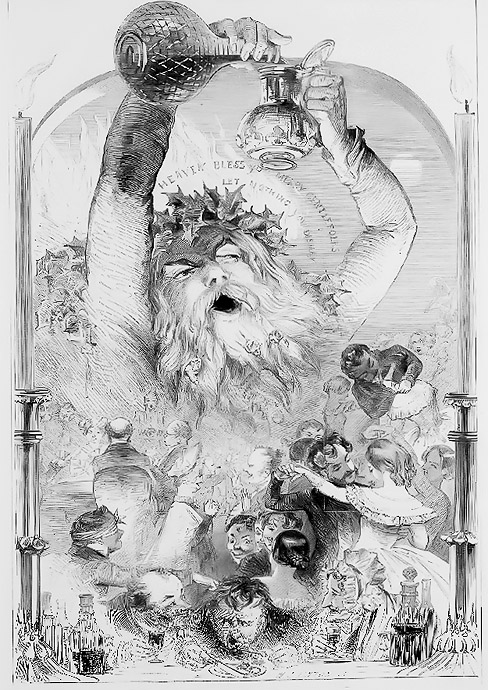
"'Old Christmas' is come for to keep open house
And scorns to be guilty of starving a mouse.
Then come, boys, and welcome, for diet the chief,
There's plum-pudding, roast goose, minced pies, and roast beef,
Then let us be merry, and taste the good cheer,
And remember 'Old Christmas' but comes once a year".
Since Medieval times, mischievous and raucous "Father Christmas" had overseen
Christmas merriment, specializing in "revelry", "trickery" and "wild excesses"!
In this 1847 illustration, he appears even a bit Bacchus-like.
And, during the first half of the 19th century these earlier customs continued with gusto.
In the year 1800 Queen Charlotte (consort of George III),
decided to hold a large Christmas party for the children
of the principal families in Windsor, as well as many of the poor.
As has often been the custom in her native Germany,
the Queen potted up an entire yew tree,
covered it with lighted candles, baubles and fruit,
loaded it with presents,
and placed it in the middle of the drawing-room floor at Queen’s Lodge.
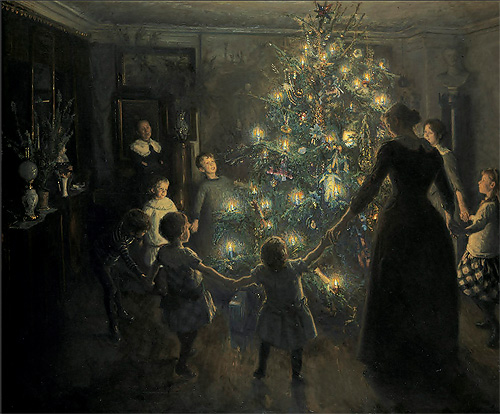
“It glittered with glass and crystal and the scent of fruit and spice filled the drawing room,
capturing the heart and imagination of all who saw it”.
This was Great Britain’s first "British"; full "Christmas tree".
Prior to that time, only candlelit evergreen branches had been used.*
Just as the flame from candles lit the early tree,
so the flames in the fireplace warmed winter rooms ... in addition to food.
And whilst some cooking tools were reserved for the kitchen, others, as
Silver Toasting Forks
were for the drawing and dining room fireplaces.
“Fireplace cooks” ranged from “amateur epicureans”,
to hungry university students, each trying their hand
at toasting cheese sandwiches, crumpets, roasting apples - even puddings
Below are two toasting forks, one from 1800, and a traveling "telescopic" fork from 1808.
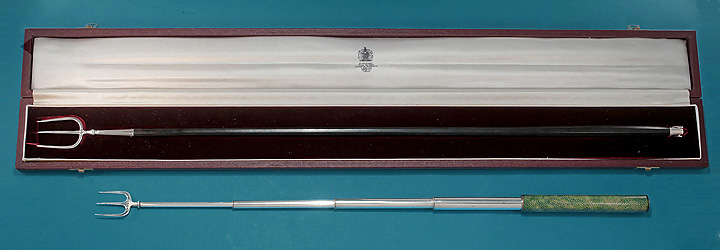
George III Silver Toasting Fork, JR (presumably Josephus Read), London 1800, 30.75" Long
in a later leather and velvet-lined fitted case, retailed by Asprey, London
George III Telescopic Silver & Shagreen Traveling Toasting Fork, H.M, London
expanding from 5” in its shagreen case, to 21.5” when fully opened
Incidentally, the electric toaster was a 19th century Scottish invention - Alan MacMasters in 1893.
And perhaps, about 1810, whilst roasting an apple over the Yule fire,
maybe somewhere along the Firth of Tay -
a wee dram of brandy or Scotch Whisky might be sipped from an exotic
Silver-Mounted Coconut Cup
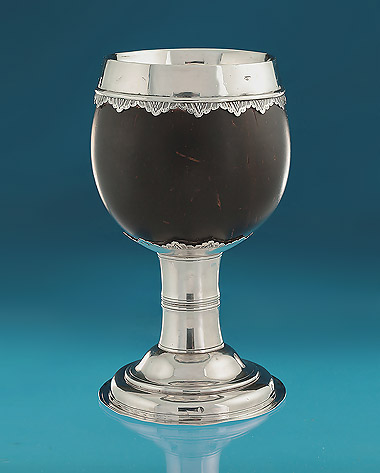
George III Scottish Provincial Silver-Mounted Coconut Cup,
William Young, Dundee, Scotland, c1810, the nut in exceptional condition
Also in that room - before the fire - might be four or five carolers,
singing from the just-published "Carols Ancient and Modern" (1823),
the carols perhaps including :
the old Welsh carol, "The First Noel", published with the old wording;
"Angels from the Realms of Glory", written in 1816; or maybe
"Silent Night", first sung on Christmas Eve to a soft strumming of a guitar, in 1818.
Firelight would greatly assist in reading new lyrics... but moreso the light of nearby candles.
(There were no light switches until 1884)!
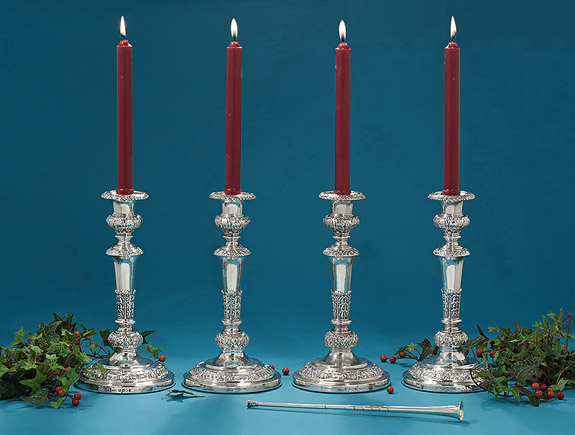
Good Set of Four George IV Neoclassical Silver Candlesticks, Creswick & Co. Sheffield, 1820
And perhaps after the crumpets and the caroling, some fine champagne,
chilled in also ice-filled wine coolers :
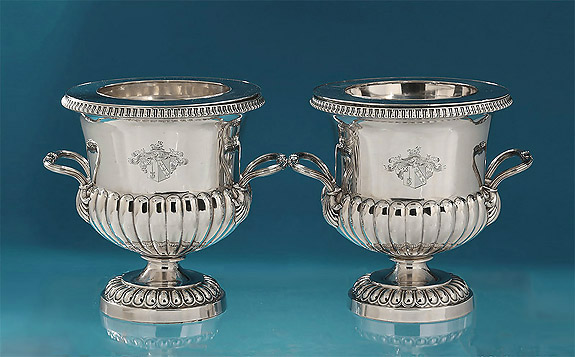
Good Pair of Matthew Boulton Old Sheffield Plate Wine Coolers, England, c1815
Crested to each side with marital arms of Halliday and Harvie
And furtherenhancing the Christmas merrymaking were all manner of small finery :
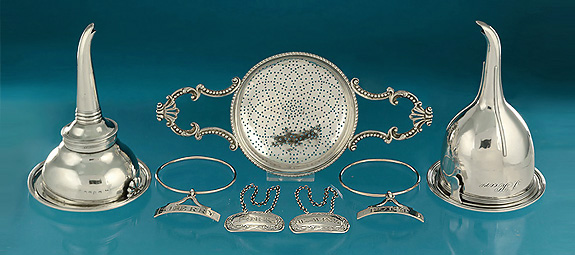 w w
such as Georgian wine funnels & stands, bottle tickets and punch strainers (recently"published"!) -
to both the ritual of wine...and the winter room.
In 1820 George IV assumed the throne of England.
Grandeur and opulence thrived during his 10 year reign
moreso than any reign since Charles II.
In 1822, shortly after his lavish coronation, George IV visited Scotland,
where in Edinburgh, only a few days before Christmas!
at Provost’s Banquet in the Parliament House,
George IV gave a banquet having 100 courses!
"Father Christmas" must have been overjoyed!
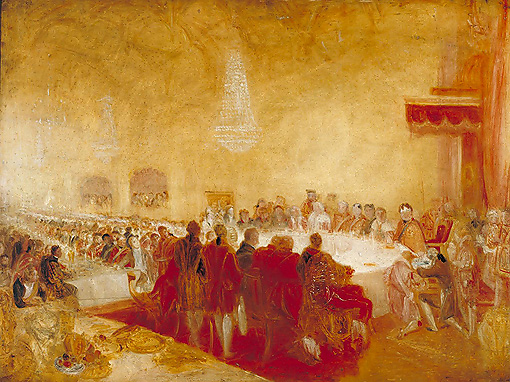
Above, the banquet is immortalized by JMW Turner, now housed in the Tate, London.
In 1824, Ludwig van Beethoven's "Symphony No. 9 in D minor, Op. 125", was first performed in
Vienna. It ended with the powerful chorale "Joyful Joyful We Adore Thee".**
George IV was quite taken by silver. Throughout his life, he added to the already large “Grand Service”,
the service numbering over 4000 pieces at his death. Among the major contributors to that service was
master silversmith Paul Storr, including candelabra and large service pieces,
as well as flatware, and the extremely popular "King's Pattern".
The “Grand Service” ( Royal Collection) is still in use today for state banquets and ceremonial affairs.
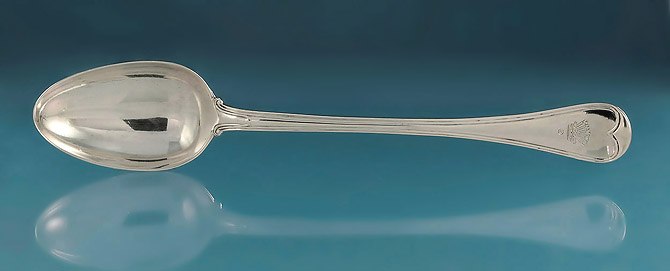
William IV Silver "Military Thread" Basting Spoon
Paul Storr, London, 1835, the terminal engraved with a crest for the family of Astley :
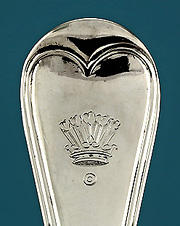
"Out of a ducal coronet or five ostrich feathers argent"
Below the crest is engraved 'an annulet' which is the mark of cadency for a fifth son
And below in the "King's Pattern", heavy, ornately cast with shells and honeysuckle,
is a very fine mid-19th century silver salad service set.
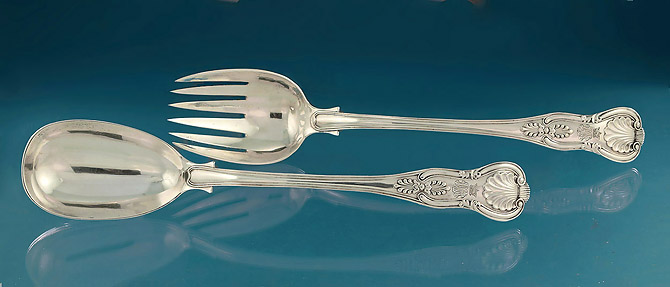
Fine & Heavy Pair of Victorian Silver Salad Servers, Kings Pattern
John Lias & Henry John Lias, London 1850 & 5
Also during the early 19th century, THE TURKEY (to the boar’s long-lasting pleasure)
finally became the Christmas superstar.
During the 18th century, the birds had been rather expensive, that cost moderating in the 19th.
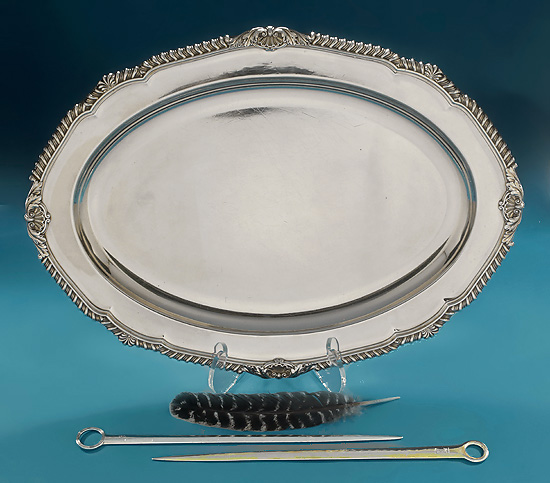
George III Matthew Boulton Old Sheffield Plate Meat Platter, c1810-15 (for the bird)
and Two George III Silver Meat Skewers
(these hold the bird together when the bindings are removed, then being used to carve against)
HOWEVER, IN THE MID-19TH CENTURY,
A CHANGE BEGAN TO OCCUR IN "CHRISTMAS".
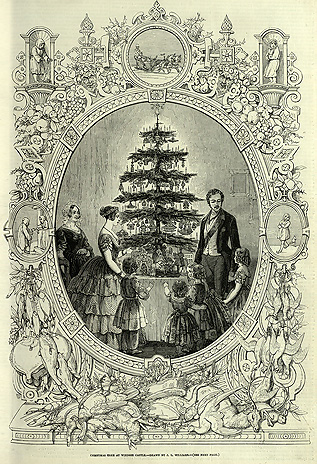 |
Concurrent with the early 19th century opulence,
a new
"sense of Christmas"
was arising.
Only few years before
the 1847
'London Illustrated News"
depiction of "Father Christmas",
the engraving to the left appeared,
also in the "Illustrated London News"(1842),
depicting Queen Victoria,
Prince Albert and their children, gathered
around a Christmas tree at Windsor
Castle.***
This image was widely seen, quite popular,
and brought about the concept of Christmas
as an intimate "family celebration".
|
| |
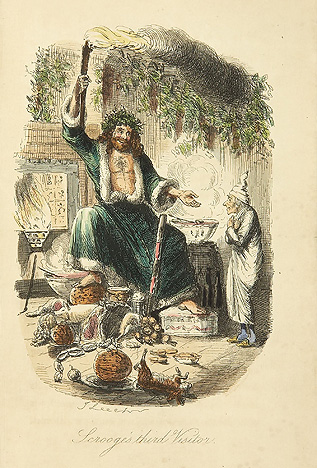 |
Also in 1843, Charles Dickens published his
Christmas classic.
"A Christmas Carol".
Dickens recalled the poverty of his youth
and brought forth those trials,
making more poignant the Christmas season,
as the four ghosts of Christmas
visited Ebenezer Scrooge,
including "The Ghost of Christmas Present".
Dickens spoke his thoughts on Christmas
through this ghost :
those glorifying the Victorian family,
and embracing closeness of family, humility,
generosity and goodwill to all men,
and acts of charity to the poor.
|
1843, the first "Christmas Card” was sent by John Cole, first director of the V&A, London.
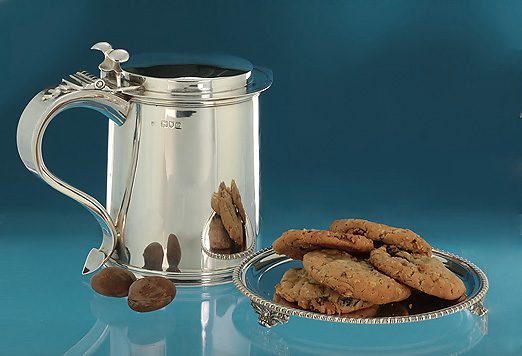
About That Time Also Came
"A VISIT FROM ST. NICHOLAS"
"St. Nicholas"
had been a very popular 4th century saint, whose legendary habit of secret
"gift-giving"
made him revered throughout Europe, particularly in the Low Countries.
The Dutch name for St. Nicholas was "Sinterklaas",
the name coming to the Americas with the early Dutch settlers.
On December 23, 1823, in America, "A Visit from St. Nicholas" had been published.
It was immediately popular in both America and Great Britain.
We also know this poem as
"The Night Before Christmas".
Instead of "Father Christmas", with his uproarious feasting, drinking and regaling,
here was a jolly large bearded fellow in a red suit in a sleigh with 8 reindeer,
coming down the sooty chimney, on a cold snowy night - fire burning –
and bearing gifts for children!
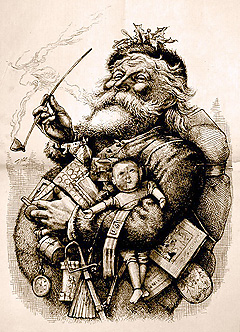
"Merry Old Santa", an 1863 illustration by Thomas Nast
By about
1850, the long-reigning mischievous
"Father Christmas",
(whose purpose had naught to do with charity, gift-giving or children)
began to
merge with the jolly gift-giving "Sinterklaas"
– and voila!
"Santa Claus" - and his bundle of toys...
...for whom to this day, we still leave a Cookie (or two) & Milk.
A Large & Fine Victorian Silver Tankard, in the "Charles II Manner", Gibson & Langman, London 1898
and A George IV Silver Waiter, William Bateman, London 1825, Arms of Goodwyn
About 1850, "Jingle Bells" was written,
followed by "Up on the Housetop" in 1860.
And perhaps a few NUTS ...
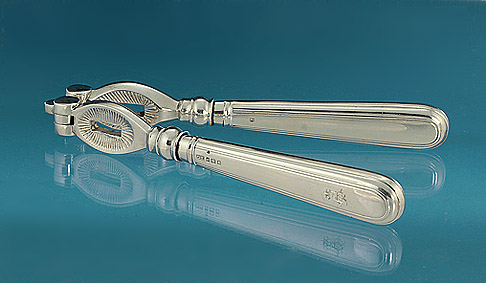
Good Pair of George V Silver Nutcrackers, George Howson, London, 1926
Good silver nutcrackers from the 19th century are very difficult to find.
So we have added this fine pair from 1926, by George Howson (Harrsion Bros.& Howson,
the company achieving a Royal Warrant from both Queen Victoria and Edward VIII).
In 1892, the Christmas favorite, "The Nutcracker",
a two-act ballet, was first performed to a score by Pyotr Ilyich Tchaikovsky.
In 1885, another Christmas favorite was written : "Away in a Manger".
And, of course, the '20th century' continued to bring us more 'traditions', as
the Macy's Thanksgiving Day Parades (from 1924),
Bing Crosby and "White Christmas" (1941),
and ...
"All I Want for Christmas Is My Two Front Teeth", in 1944 for Spike Jones,
and 1962, immortalized by Alvin & The Chipmunks!!
One night remained much the same :
THE TWELFTH NIGHT, and THE CAKE!
We opened this Christmas series with a 17th century painting depicting
"King of the Bean" regaling at a 12th Night celebration in 1626.
Glasses were raised, feasting to excess, all merrily around the table, where
a "King" had been chosen to be the "Lord of Misrule" –
by means of a bean baked in a cake.
This had been tradition (save a few years) from Medieval times through the 19th century. ,
By the early 19th century, the cake itself had become very elaborate, with sugar frosting and gilded paper
trimmings, often decorated with delicate figures made of plaster of Paris or sugar paste.
Many cakes were so large that they were very difficult to carry!
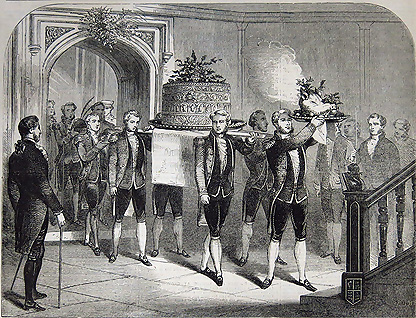
Primarily due to the cake – plus the games and wassailing -
"Twelfth Night" is reported to have been the most popular day of the Christmas season
This cake is also known as the "Christmas Cake",
Also in "King of the Bean", merrymakers are shown toasting, with their jugs and glasses in the air,
most of these glasses known as "roemers".
There are a few – but not many – glass roemers from 1626 that still exist.
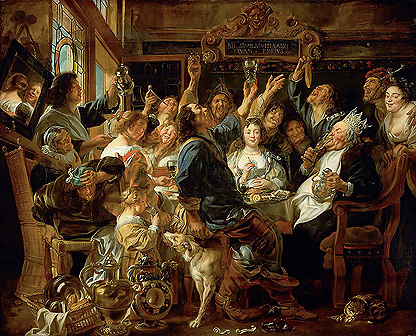
However we happen to have a set of Nine 19th Century Green Glass Roemers,
with a most interesting provenance :
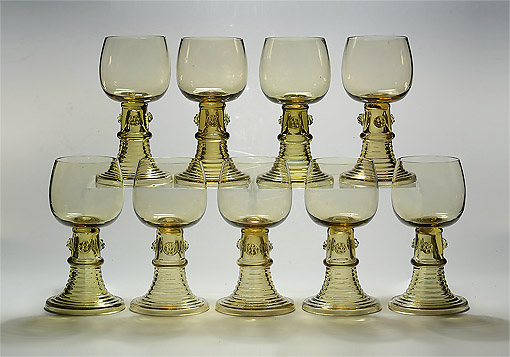
Rare Set of Nine Continental Glass Roemers, Dutch or German, c1880
By repute, a gift to the British Royal Household by Tsar Nicholas II,
in 1909 to King Edward VII,
and gifted to the great uncle of the previous owner
upon his retirement from service to the British Royal Household.
Waes Hael!!
And May MERRIMENT Follow You EVERYWHERE
This Christmas Season!
Footnotes :
* Legend related that the lighted tree was popularized by Martin Luther in 1536, whom when strolling
one night in a pine forest in Wittenberg, glanced up through the canopy at the stars twinkling above him.
Inspired, he brought a fir red into his house and lit it with candles.
Luther hoped that this would remind his children of the heavens.
Throughout the 17th century, trees of various types that were illuminated by candlelight became popular across Southern Germany.
However meanwhile, in Great Britain, an evergreen branch was illuminated with candles and baubles.
Under this bough, the children laid the presents they mean for their parents.
** Beethoven was completely deaf by the time that this symphony was performed,
and could not hear the applause.
*** It is generally stated Prince Albert brought the custom of the Christmas tree to Great Britain.
However, it was indeed the first "fir" tree.
Queen Charlotte’s tree had previously become very popular among the British aristocrats.
Paintings & Illustrations in Order of Appearance :
"Father Christmas", 1847, "Illustrated London News", 1847
"Joyful Christmas" , Viggo Johansen, 1891, Hirschsprung Collection, Copenhagen, Denmark
"George IV at the Provost’s Banquet in the Parliament House, Edinburgh",
JMW Turner, The Tate, London
"Christmas Tree at Windsor Castle", from the Christmas Supplement to the "Illustrated London News",
1848, British Library, London, England
"The Ghost of Christmas Present", (with his foot on one of the "immense twelfth cakes"),
"A Christmas Carol. In Prose. Being a Ghost Story of Christmas", Charles Dickens,
with 1843, illustration, John Leech
"Merry Old Santa Claus", from the January 1, 1881 edition of “Harper’s Weekly”, Thomas Nast,
reprinted from 1863
"A Christmas Cake and Boar’s Head, Twelfth Night", Engraving; npr brightspot
Also known as "Feast of the Bean King", Jacob Jordaens, c1640, Kunsthistorisches Museum, Vienna
(The above courtesy of Creative Commons)
Inventory Photography : Millicent F. Creech
For "Tales of the 17th Century The British Christmas", Please Click Here :
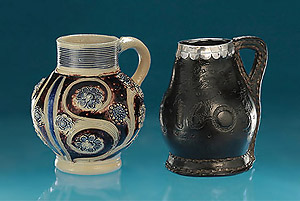
For "Tales of the 18th Century The British Christmas", Please Click Here :
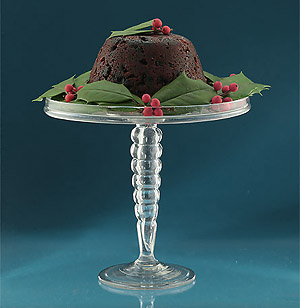
|